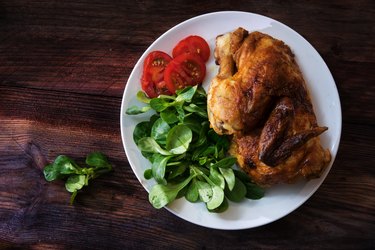
There are myriad ways to prepare chicken, which is a protein staple around the world. One approach is to roast a half chicken, a dish that requires following a straightforward recipe and the proper poultry-handling safety precautions.
Baked Half Chicken Recipe
Video of the Day
For guidance on how to properly bake a half chicken, the USDA's ChooseMyPlate provides a simple recipe for 1 pound of boneless, skinless chicken:
Video of the Day
- Heat the oven to 350 degrees Fahrenheit.
- Place the chicken in a baking pan or casserole dish.
- Season with 1 teaspoon of pepper, 1 teaspoon of garlic powder, salt (optional) and any other preferred spices.
- Bake for one hour.
- Check the chicken for doneness using a meat thermometer.
- Remove from the oven and serve.
Serve baked chicken with sides like this LIVESTRONG.com recipe for Thanksgiving Garlic Smashed Potatoes and our Roasted Green Beans, Mushrooms and Onion. For your baked chicken to be at its healthiest, Mayo Clinic recommends removing the skin, using flavorful marinades and reducing your portion size.
Chicken Cooking Tips
Before roasting chicken, you'll want to know the basics. The USDA Food Safety and Inspection Service (USDA FSIS) recommends cooking chicken to a safe internal temperature of 165 F. Don't partially brown chicken and finish cooking it later. If you're planning to use a marinade, you can marinate chicken in the refrigerator for up to two days.
Looking for a delicious glaze or marinade for your half chicken? Our Fresh Mango Marinade is a tasty option:
- 1 fresh mango
- 1 tablespoon canola oil
- 2 tablespoons orange juice
- 2 teaspoons ginger root
- 2 teaspoons brown sugar
- 2 garlic cloves
- 3/4 teaspoon salt
- 1/4 teaspoon red pepper flakes
- Peel, remove the pit and chop the mango.
- Peel and finely chop the ginger and garlic cloves.
- Add all ingredients to the pitcher of a blender and blend until pureed.
- Marinate up to 2 pounds of chicken in the refrigerator in a leakproof container or zip-lock bag for at least two hours. Discard any marinade left over after cooking the chicken, advises the USDA FSIS.
Read more: How to Bake a Plain Chicken Breast
Poultry and Food Safety
The USDA FSIS lays out chicken food safety tips. Some recipes may instruct you to rinse chicken before cooking it. The USDA FSIS advises against this, as washing the poultry could splash chicken juices, spreading bacteria. Another don't: allowing raw chicken to come into contact with other foods in the refrigerator. Sanitary refrigeration and thorough cooking will help prevent foodborne illnesses, says the USDA FSIS.
Do wash your hands, boards, knives or anything else that comes into contact with raw chicken. And do make sure to cook your chicken thoroughly. This will ensure that the bacteria has been killed. FoodSafety.gov advises always cooking poultry of any type until its temperature reaches 165 F.
According to the USDA FSIS, it's OK to refrigerate chicken at a temperature of 40 F or below for a maximum of two days if raw and four days if cooked. The Centers for Disease Control and Prevention says it's safe to refrigerate or freeze leftover chicken within two hours, or one hour if the ambient air temperature is above 90 F.